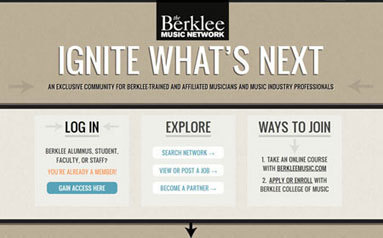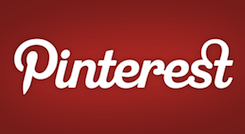Erik Qualman's Blog, page 651
October 11, 2012
The Future of Marketing Automation: Steven Woods, Eloqua CTO and Co-Founder, Weighs In


Marketers are growing ever more sophisticated, thanks in part to the explosion of publicly available customer and prospect data. The days of sending blanket marketing messages are numbered, as companies will hyper-target and segment to bring each consumer content that is relevant and exciting to them. Few people in the world are better equipped to provide a brief marketing automation education than Steven Woods, CTO and Co-Founder of Eloqua. We sat down with Steven to get his take on the future of the industry. For even more knowledge, you can read his insights plus those of nine other marketing automation experts in our new white paper 52 Secrets to Marketing Automation Success.
Steven shared that over the past twelve months, we’ve seen two major developments in marketing automation. First, there has been an evolution in the way we understand our buyers. A decade ago, a marketer had very limited information that they truly knew about a potential buyer: title, role, industry, and other demographics.
Marketing automation advanced when we were able to layer on the concept of ‘digital body language’ (what prospects were doing on a web site), and determining their interests based on their online activities.
Now we are gaining an understanding of whom a consumer trusts, from where he or she is collecting information, and how that information is received; or, the social piece of the picture, if you will.
The other important development is the technological advancements we’ve seen. Marketing automation was built and relies on the idea of software as a service (SaaS). The industry became what it is today because of what’s possible with SaaS. As SaaS has become the accepted industry standard that all of these systems are built upon, we are seeing not just innovation at a company level, but innovation of an ecosystem.
The future of marketing automation is not just about what the platform can do on its own, but what can be added to it. We’re seeing that other powerful applications can snap in to marketing automations systems and further enhance your understanding of the buyer.
The best marketers today are no longer looking at prospective buyer activity as a series of one-off events (i.e. what did the prospects do on our website? Did the prospect attend our recent webinar?), but are rather tying this information all together to create a cohesive view of the buyer across a wide variety of touch points. When this integration is done well, a marketer can snap different applications to the marketing automation platform to create a 360 degree-view of the customer.
As for where marketing automation is heading, Steven believes we have exciting times ahead. Modern marketers will begin to break down the silos inside their organizations to analyze how their efforts coalesced to impact the business. In fact, expect to see marketers stop thinking that just having a Facebook presence, LinkedIn Group, recurring webinars and in-person events as sufficient. Marketers will transfer the data collected out of the various silos to approach the question: did this effort drive revenue for my business?
Marketers will showcase their ability to say: “Yes, I run events, host webinars, have SlideShare, Facebook and LinkedIn, and as I tie the data together, I understand how buyers tend to progress towards revenue.” These marketers use this data to uncover the buyer’s pathway – where a potential buyer starts learning about a company and how that ultimately leads to a purchase. To optimize this pathway, sophisticated modern marketers will say, ‘To be the best in the world, our company needs to invest a little more here and a bit less there to drive a lot more revenue.’
We’d like to thank Steven for his fascinating insights on the future of marketing automation. For even more on what to expect in 2013, download our free white paper 52 Secrets to Marketing Automation Success.
Does your company currently use a marketing automation system to convert leads into customers? Tell us more on Twitter.
[image error]
October 10, 2012
Can Social Media Lead to a Home Robbery?

It can be something as innocent as a tweet or share that can have your life turned upside down.
You use one of your social media networks, Twitter or Facebook as an example, to let a friend, family member or others know that you are going away for a week’s vacation. In turn, you tell millions of people through that one social media message, including some who may live nearby, that your home will be vacant for the week.
Once your message hits a social media network, someone with bad intentions scanning the particular site you announce your trip on gets an idea. After doing a little digging online, they come up with your home address. Next, they or someone they associate with stop by your residence unannounced while you are away. What happens next is your worst nightmare.
So, think it can’t happen to you? Think again?
While using social media has many different advantages for users, it can also put them and their possessions in peril at times.
In order to lessen the chances of a home robbery and improve your home security situation, keep the following in mind:
* Use social media to your advantage – Instead of telling the world you are on a business trip or personal vacation, do just the opposite with your social media channels. Inform people that you just finished some work around the home, are looking forward to a day or two off from work to lounge around the house, or are sick and taking a few days at home to recover;
* Go private on your social media settings – While you may like sharing your information with the world, some people will use those details to hurt you. In order to lessen the chance of a home robbery while away, only allow individuals or businesses you know personally to read your Facebook shares and tweets on Twitter. It is also important to keep in mind that privacy settings change frequently on such sites, meaning potential thieves could gain access to your account/s. ;
* Don’t post vacation or business trip photos will away – In the event you are taking a relaxing vacation or attending a business conference, do not networking photos or poolside images, etc. until after you have returned home. Just as comments can alert would be thieves that you are not home, posting images can also land you in trouble;
* Choose your online friends wisely – As you take the time to decide whether or not to befriend someone on Facebook or allow them to follow you on Twitter, check out their profile. If something catches your eye about their profile that does not sit well with you, consider either not corresponding with them, even blocking them if necessary. Lastly, don’t give out personal details about yourself, family, home, etc. unless it is in a private discussion with someone you know.
While social media can be a great vehicle for keeping in touch with both old and new friends, don’t let a share or tweet come back to haunt you.
Photo credit: thisoldhouse.com
[image error]
October 9, 2012
New Research Shows Companies Not Using Social To Reach Full Potential


As social marketing champions, we at Awareness eagerly devour new reports on the state of the industry. When influential thinkers Denis Pombriant from Beagle Research and Esteban Kolsky from ThinkJar collaborated on a Social Media 2012: State of Adoption white paper sponsored by Microsoft, D&B, Salesforce.com, Moxie Software, Kana and Attensity, we couldn’t wait to dive into their findings. Denis and Esteban surveyed over 300 business people from a wide variety of industries, 27% of whom names themselves SVPs, C-level executives or board members.
The major finding? Social marketing is still an early market, not yet being leveraged to its full potential. This mirrors findings from our State of Social Marketing Report as well.
The survey found adoption is high, with over 60% of respondents stating they have implemented social media or would within 6 months. However, it’s clear that not all business people are equipped to use social strategically. The clearest evidence of this is the number of respondents who use social media simply as a low-cost broadcast tool, instead of a way to explore novel interactions with customers and prospects.
Denis and Esteban conclude that while obstacles to adoption remain, they are largely not technical. Most people throughout the business understand the power of social, but lack clarity around how to get started. Perhaps not surprisingly, those in the company who understand social least, named as HR, operations and legal, have the most concerns around social media implementation. Their concerns center around issues in security, legal and relevance to the business.
The biggest potential for social lies in the ability to capture customer data for analysis and be used as a disruptive way of reaching customers. Instead, they argue too many businesses are still relying on social as an outbound broadcast channel, more closely aligned with traditional marketing channels. This finding suggests social media usage for business is still in its early stages, reflecting a similar adoption curve to various other channels at their inception, including email and e-commerce.
Marketing and customer service departments are currently using social more effectively than the sales teams, the report suggests. To aid the sales process, social media is currently being used for early stages in the funnel, including prospecting and relaying prospect information to the sales team. Customer service uses social to perform activities like providing accurate information to customers quickly and improving first call resolution. On the marketing side, Denis and Esteban report that marketers are using social to capture supplementary customer data to use in nurturing programs. At Awareness, we believe this has far-ranging implications, as this data collection can augment sales, customer service, product development and marketing programs. As marketers begin to use this data to develop custom scoring, they will bring increased sophistication to the field.
Esteban and Denis provide some clear recommendations for social marketing vendors and companies alike, marketers lack a framework to do social well. Currently, there’s a void around education; marketers need more information around lessons learned, best practices, frameworks, and methodologies. These assets will equip marketers with what they need to move the needle on marketing programs and provide direction and clarity to nascent programs.
To compare Denis and Esteban’s results to ours, check out our free State of Social Marketing Report and Denis’s key takeaways from their survey, Social Media 2012: State of Adoption. Marketers, weigh in! Are you yet collecting data on customers and prospects to enhance the sophistication of your marketing programs? Tell us at @Awarenessinc.
[image error]
October 8, 2012
How To Handle Negative Feedback On Your Blog

Blogging and social media have changed the ways of marketing for companies  because of their ease, outreach and the fact they’re budget friendly. However, with great new marketing ways come new marketing downfalls. Before blogging and social media were created, if a fan, reader, visitor or customer had a negative comment to make they picked up the telephone, emailed or even wrote a letter. And that’s even if they had the time to do so. Now disgruntled fans, readers, visitors and customers can rock your world in a matter of seconds with one simple public post on your page. How you handle and react to that negative feedback on your blog is very important because it is now out there for the public to see and can affect your brand negatively or positively.
because of their ease, outreach and the fact they’re budget friendly. However, with great new marketing ways come new marketing downfalls. Before blogging and social media were created, if a fan, reader, visitor or customer had a negative comment to make they picked up the telephone, emailed or even wrote a letter. And that’s even if they had the time to do so. Now disgruntled fans, readers, visitors and customers can rock your world in a matter of seconds with one simple public post on your page. How you handle and react to that negative feedback on your blog is very important because it is now out there for the public to see and can affect your brand negatively or positively.
Keep calm and carry on. As soon as you are notified of a less than pleasant remark from a reader, the first thing you want to do is take a deep breath. It is human instinct and completely normal to get defensive and react negatively when faced with ill words. Instead keep clam, take a deep breath and think before you respond.
The faster you respond the better. This almost becomes a game because once that comment has been posted you can count on your other readers seeing it. The ball is now in your court and once other readers see the comment they will wait for your response. Addressing the comment quickly will show your upset reader, as well as your other readers, that you are in the game and on the ball.
As much as you may want to delete the comment, do not delete it. Think of the negative comment like a child that gets caught taking something that doesn’t belong to them. When you approach the child, the first thing they do is hide the item behind their back, signifying to you that they know they have done something wrong by taking the item. Taking away or deleting that comment will only show your unhappy reader and other readers that you have done something wrong. The only exception to deleting is if the comment contains curse words or any other offensive language. If that is the case, take a screen shot of the comment and file it away for reference if anything else progresses with that problem.
Do not apologize. This may puzzle you, but one of the most important rules in any industry or business is that you never admit to doing something wrong. Though there are obviously certain cases when it is needed and okay, you should only use apologies when absolutely necessary. Typically negative comments come from unhappy readers that aren’t satisfied with a lot of things in life. Avoid saying, ‘I am sorry’ but use phrases like ‘I understand’, ‘I want to remedy this situation’, and ‘I’d love to discuss this with you’ etc.
Take them offline. Once you have addressed the negative comment quickly with ‘I’d love to discuss this situation with you more’ direct them offline. You want the negative exchange to end right there and to continue addressing the problem offline. Ask the reader to message you with their email address and/or phone number so that you can discuss everything. This shouldn’t be too hard because most readers are happy to speak with you offline.
Treat the negative comment like you would with any other comment. Just because the comment was made on your blog or on your Facebook doesn’t mean you treat and resolve the problem any other way. Treat it as if the person said it to your face and not online. Nothing changes.
Don’t take it personally. One thing you have to learn when you put yourself out there for the whole online world to see is that you will not always please everyone. As much as you want to make everyone happy, it just doesn’t work all the time. Take notice that for every negative comment you get, you probably have at least five positive comments. Don’t take the comment personally and don’t take offense. Learn from it and move on.
No one is perfect, and in a world where social media and blogs rule, we are bound to run into a few unhappy people. The only difference in a negative comment or review is that it is public and not private. Handling your negative comment correctly will speak volumes towards your work ethic. When that happens it is important to remember to remain clam, address it quickly, don’t delete it or apologize, take it offline and never take it personally. Good luck and happy blogging!
Article from: http://www.longhornleads.com/blog/2012/how-to-handle-negative-feedback-on-your-blog/
[image error]
Power to the Online People
October 7, 2012
Is Your Small Business Facing Social Media Questions?

As you sit in your office today, take a moment to ponder just where social media rests on your itinerary of important tasks each day.
For the small business owner who is utilizing sites such as Facebook, Twitter and LinkedIn to promote their brand, good for you. For the man or woman running a company who fails to see the importance of SM, there is still time to recover and let social media do wonders for you.
To anyone who may have doubted the power of social media, they need only look at the news this week from Facebook.
The social media giant reported that it had recently topped the one billion mark in users, with CEO Mark Zuckerberg noting, “This morning, there are more than one billion people using Facebook actively each month. If you’re reading this: thank you for giving me and my little team the honor of serving you.”
The good news for Facebook was something to share, especially given the rocky year that Zuckerberg and Co. have had after the company’s infamous initial public offering (IPO). There have also been questions raised as to how legit all the Facebook user accounts are, given admissions from the company itself that approximately 8.7 percent of its user accounts could, in fact, be fake and/or abandoned.
As Facebook looks for more means to accrue revenue and perhaps pinpoint just exactly how many accounts are indeed credible, there is still no doubt who the leader in social networks is.
With that being said, is your small business taking advantage of all Facebook and the other prime social mediums have to offer?
If the answer is no, consider the following:
* Free advertising – For the small business owner that is looking to save some money on advertising, social media is the perfect solution. Unlike traditional print or airwave advertising, talking about and promoting your brand on social media venues is essentially free. Yes, the time and effort necessary to do it correctly are required, but don’t you think the investment is worth it? You have the benefit of a large audience at your fingertips, many of whom could be your next customer;
* Real-time interaction – Whereas much of small business dealings in the past revolved around visits from clients and phone calls, social media is a great means to connect with both current and potential customers in real-time. Numerous recent studies have shown that more and more consumers are using the Internet to both browse and purchase products and services. With that being the case, being active with business pages on Facebook, Twitter, Google+ and other key social media venues just makes sense;
* Know what people are saying – Lastly, knowing what both consumers and competitors are saying about your business on social media helps you in several ways. First, you can respond in real-time to any inaccuracies or negative comments about your business. Second, you can help consumers with questions they have about your products or services in a quick and timely manner. Finally, you can be engaged with consumers 24/7/365, showing that you are an authority in your line of business, always there to assist customers.
Whether you are fully into social media, use it sparingly or have not tested the waters yet, your small business has nothing to lose with using it.
In fact, your small business might even come face-to-face with a whole bunch of new customers when you become more social.
Photo credit: smallbizdaily.com
[image error]
October 5, 2012
The 10 Most Impressive College Pinterest Pages

Pinterest is quickly establishing itself as a great social media resource for colleges, and many are finding great things with their Pinterest pages. Plenty are sharing school highlights, fun game day ideas, and cool photos from campus, and we’re really impressed. Check out our list of the 10 most impressive college Pinterest pages to get inspired and see what’s possible for higher education on Pinterest.
Texas A&M University:
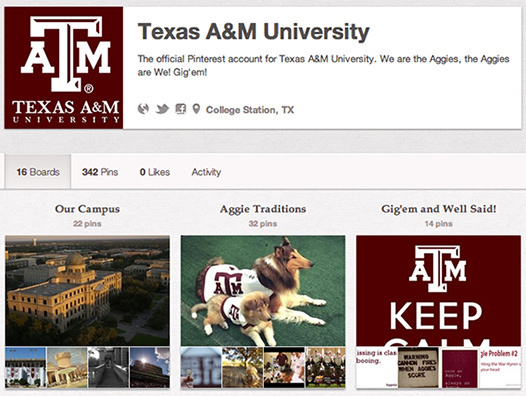
With more than 3,000 followers of 16 boards, Texas A&M has one of the most popular university Pinterest accounts. On their Pinterest page, A&M shares campus photos, traditions, and sayings, exploring the school’s culture. Plus, the school shows off just how much A&M becomes a part of students’ lives, with board including Aggie I Do, Future Aggies, and Aggie Moms. There are also practical boards exploring ideas for tailgating, dressing up for game day, and “marooning your room.”
Drake University:
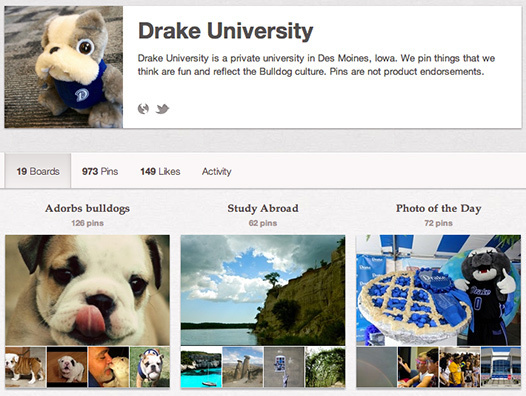
Drake University’s Pinterest appeals not just to university students, but bulldog lovers, as they have a wildly popular Adorbs bulldogs board featuring, of course, amazingly adorable bulldog photos. But beyond promoting the school’s mascot, Drake University does a great job of finding great pins to share with university students and alumni, including room decor, ideas for studying abroad, and inspiration for moving from backpacks to briefcases. It’s obvious that Drake has one of the most popular and well-established Pinterest pages of any university, boasting nearly 3,000 followers of its 19 different boards.
University of Oregon:
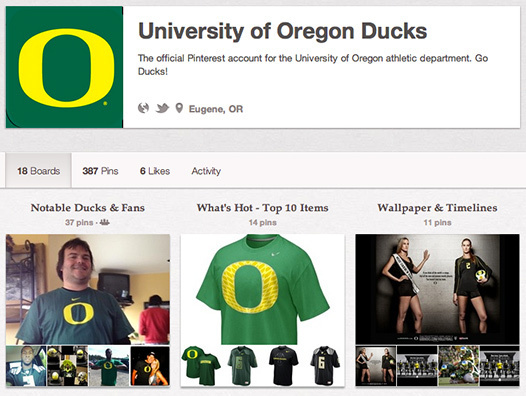
The University of Oregon has one of the most popular university Pinterest pages, with over 2,000 followers of its 18 boards. The school highlights notable athletes, fans, and experiences of the University of Oregon athletic department, plus awesome moments in Ducks history. The absolute coolest way the Ducks are using Pinterest, though, is on their Wallpaper and Timelines board, where they share exclusive wallpaper and Facebook cover photos for fans to share.
Ole Miss:
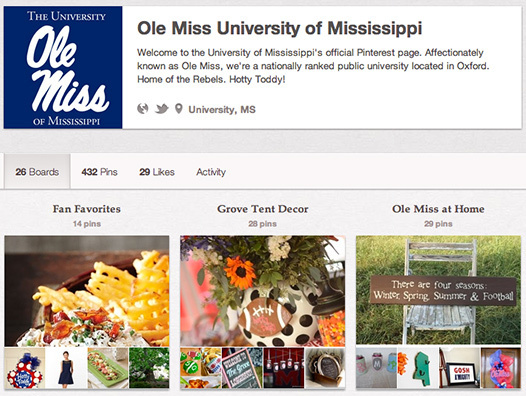
Ole Miss is doing a great job with their Pinterest page, with more than 1,500 followers to prove it. The Ole Miss Pinterest page celebrates everything University of Mississippi, highlighting Rebel Weddings, Hotty Toddy Holidays, Little Rebels, and red and blue fashion ideas. Plus, visitors can learn about accomplishments from the university, including famous alumni as well as books and screenplays from the Ole Miss faculty. Interestingly, Ole Miss has shared a successful Pin It to Win It campaign, offering free catering for the upcoming Egg Bowl to one lucky winner that’s repinned their promotion.
Marquette University:
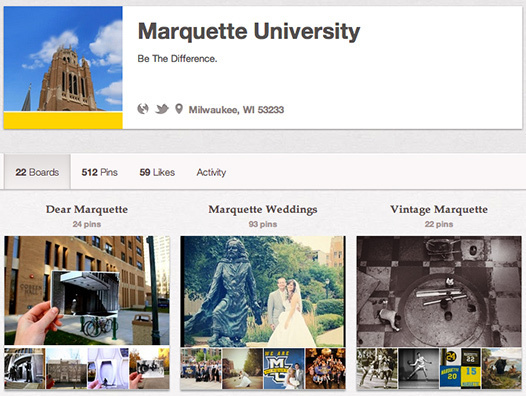
Marquette students have plenty of inspiration to turn to on the university’s Pinterest page. With 22 boards, 512 pins, and 1,200 followers, there’s a lot to explore and love. Some of our favorite boards from the university include Vintage Marquette, highlighting photos from the school’s history, graduation bucket list, and Dear Marquette, which offers then and now looks at Marquette’s campus.
Miami University:
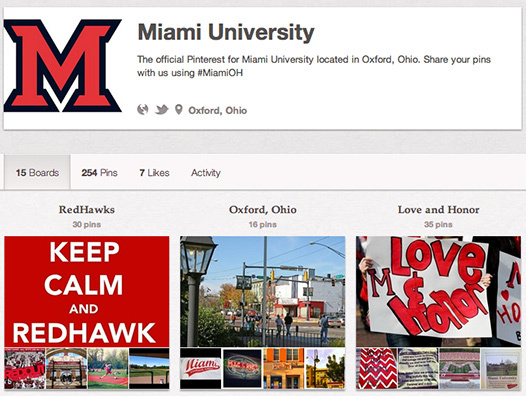
This official Pinterest page for Miami University is full of fun and learning for Miami fans. Visitors can explore Miami University’s campus and the college town of Oxford, Ohio, plus Miami traditions and wedding photos. Also really cool to check out are Miami’s ideas for study abroad, must see events, and pins highlighting awesome alumni. With more than 1,000 followers, Miami’s clearly doing something right!
University of Oklahoma:
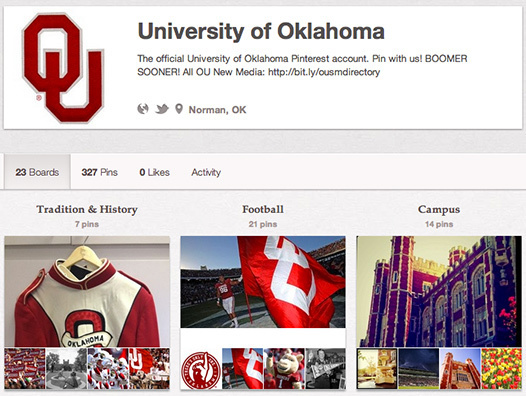
The University of Oklahoma’s Pinterest page is complete with everything you’d expect from a great university on Pinterest. There’s a little bit of everything, with a nod to history, football, and the OU campus, as well as highlights of student and alumni accomplishments, and a celebration of what makes OU unique, including landscape photography and local eats. It’s obvious that OU’s doing a great job with more than 770 followers and hundreds of pins.
Oberlin College:
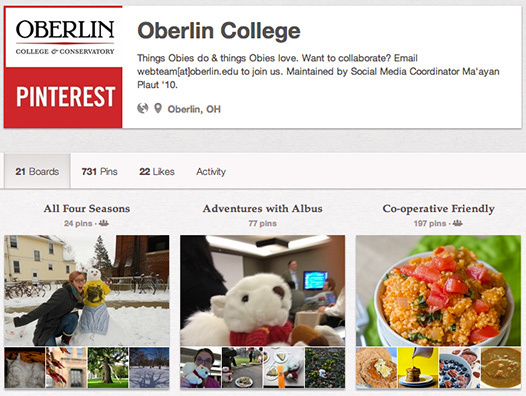
On Oberlin College’s Pinterest page, you’ll find a celebration of “things Obies do and things Obies love.” With 404 followers and over 700 pins, you’ll find resources like Obie Creations, recipe ideas that are Co-operative Friendly, and even cool pins for Bikes & Bike Style. Oberlin’s Pinterest certainly shows off the personality of the college, and offers lots of great resources for exploring what the school has to offer.
Virginia Tech:
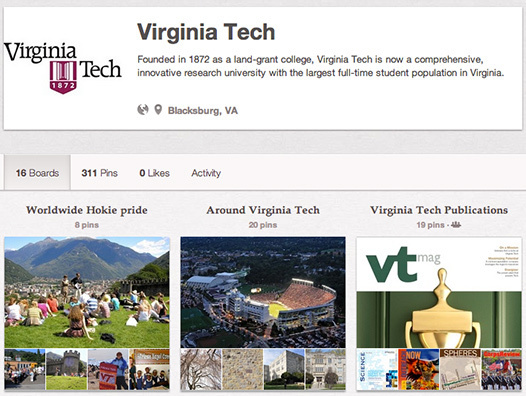
Virginia Tech’s Pinterest pages are incredibly popular, with 737 followers on the school’s main page, nearly 900 for Hokies Athletics, and more than 170 for Virginia Tech Libraries. As a group these pages do a great job spreading the word about what makes Virginia Tech great, sharing Hokie History, tailgating fun, and even Baby Hokies. We’re especially impressed by the Hokie bucket list board that shares Virginia Tech traditions that every student should experience before graduation.
Saint Mary’s College of California:
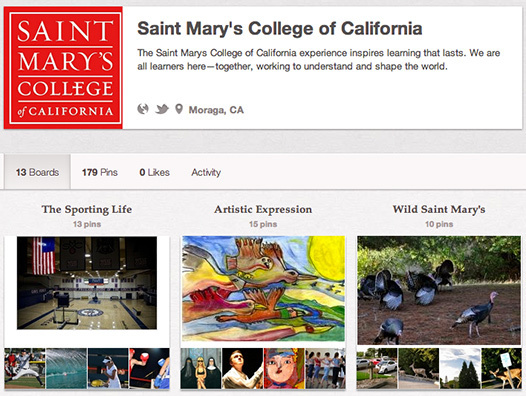
Although Saint Mary’s College of California boasts a modest Pinterest page with less than 30 followers and 179 pins, the school’s library Pinterest is a runaway bestseller. Saint Mary’s College Library has attracted more than 340 followers with 2,000+ pins exploring banned books, bestsellers, and even featuring authors on the Saint Mary’s College campus. Most interesting are the library’s book collections highlighting different categories of books, including Books You Pretend to Read, Books Made into Movies, and Cult Classics.
Source: http://www.bestcollegesonline.com/blog/2012/09/27/the-10-most-impressive-college-pinterest-pages/
[image error]
October 4, 2012
Experts Weigh In: 52 Secrets to Marketing Automation Success
 Marketing automation, or the field that enables finding prospective buyers and engaging them to become loyal customers, is one area that is yet to be explored to its full potential. Just two years ago, the adoption rate of marketing automation systems was low – under 10% among B2B organizations. But the potential for growth in the field is huge. Leading B2B research firm, SiriusDecisions, predicts that by 2015 50% of companies will embrace the toolset as part of their core marketing infrastructure.
Marketing automation, or the field that enables finding prospective buyers and engaging them to become loyal customers, is one area that is yet to be explored to its full potential. Just two years ago, the adoption rate of marketing automation systems was low – under 10% among B2B organizations. But the potential for growth in the field is huge. Leading B2B research firm, SiriusDecisions, predicts that by 2015 50% of companies will embrace the toolset as part of their core marketing infrastructure.
How can companies benefit from marketing automation? Is the investment worth it? Consider these facts:
The practice of marketing automation yields a 417% increase in revenues
Businesses who use marketing automation to nurture prospects see a 451% increase in qualified leads
In turn, nurtured leads make 47% larger purchases than non-nurtured leads

Source: http://www.comparebusinessproducts.com/content/assets/40/fyi/FOCUS-MARKETINGAUTO.png
To date, the field of marketing automation is relatively poorly understood. To address this, we discussed the state of marketing automation with nine leading thinkers in the space, including leaders from top marketing automation providers such as Eloqua and Marketo, strategists from consulting firms including Jonathan Block and Jay Famico of SiriusDecisions, David Raab of Raab Associates, and Marshall Lager of Third Idea Consulting, and front-line CTOs like Mark Lazen of Social Media Today. Their expertise is showcased in our newest white paper, 52 Secrets to Marketing Automation Success.
They provided insights across five key areas:
The Current State of Marketing Automation
The Impact of Social Media Platforms such as Twitter, LinkedIn and Facebook on Marketing Automation
The Importance of Integrating Social Data with Traditional Prospect Data Reconciling Big Data, Social Data, and Customer Data
Advances in Targeting and Outreach Thanks to (Big) Social Data
Predictions for Marketing Automation in 2013
If there was one resounding prediction for the months to come, all experts agree that marketing automation will become more main stream, as SMBs realize the potential of harnessing new potential customers. They also suggest as more marketers adopt the technology, refinements will be made to the tools’ usability.
As businesses get more competitive, marketers will rely on tools to help capture increased revenue opportunities, both from recruiting new customers and better serving current customers. To read the full insights from the experts, download our free white paper, 52 Secrets to Marketing Automation Success.
Marketers, do you currently use a marketing automation system? Have you seen increased revenue as a result? Let us know at @awarenessinc.
Mike Lewis
@bostonmike
[image error]
20 Awesome College Social Campaigns from This School Year

Studies show that a growing number of college students are using social media to help them choose a college, stay in touch with admissions officers, and keep up with campus events, a trend that has been shaped by the willingness of many colleges to embrace the marketing power that social media offers. From Facebook to Twitter to custom social sites, colleges have been stepping up their game in recent years when it comes to getting students involved on the web, and it has resulted in some pretty impressive social campaigns. Read on to learn more about a few of the best that emerged over the 2011-2012 school year, paving the way for bigger and better social media campaigns in future years.
SeeBlue.com:
The University of Kentucky has created an amazing portal for prospective students called SeeBlue. It offers videos and articles about real student experiences on campus, giving a very genuine impression of what attending the school is really like rather than the perfectly polished image that’s in most brochures. Students can also find out how to connect with admissions advisors, take an online tour, ask questions about the school, and even fill out their application online. The site essentially brings together everything prospective students could want or need in one easily accessible, seamless, and highly interactive space.
Highbury College Portsmouth QR codes:
This year, Highbury College Portsmouth decided to go high-tech with its advertising and postering campaign. In addition to the usual advertising information, the posters included a scannable QR code, which pointed students to the college’s Facebook, LinkedIn, and Twitter sites. This isn’t the first time the British school has used technology to get students to apply, as it has also developed a new iPhone application that allows students to both see all the courses the school offers and apply to the school itself.
Florida Atlantic University Foursquare check-ins:
In September 2011, Florida Atlantic University launched a host of social media initiatives for students, faculty, and staff, including Gmail-based student email and an FAU mobile application for smartphones. The school also created a Foursquare account that allows students to check in at locations around campus, connect with one another, and share information about the school. The account on Foursquare is also hooked up to FAU’s Facebook and Twitter accounts, making it simple for students, current or prospective, to stay in touch with the school.
University of Dayton social scholarship competition:
Prospective students at the University of Dayton can not only submit a video essay to the school, when they post it to Facebook, it can also help enter them to win a $40,000 scholarship to the school. Students can showcase why they think they should be given admission to the school (and a hefty prize to boot) through social media and friends, family, and school officials can vote on their favorites, also through Facebook, to select a winner. The contest is a creative way to connect with students, and offering to help out with tuition is a big lure in an age when college costs are skyrocketing.
Unigo college counseling:
Unigo is not a college itself, but a site designed to help students make smart decisions about what colleges to attend, offering rankings, reviews, and financial aid information. One of the coolest additions to the site, however, is socially based and allows students to connect with admissions experts, counselors, and financial aid officers directly through the site. The services come with a cost (which often isn’t exactly cheap), but for students hoping to get into top their schools, this social service could be worth it.
Loyola offers Facebook timeline photos:
Sometimes the simplest social campaigns are the coolest. Loyola University Maryland is an example of that, embracing the Facebook change to the timeline format by offering students free downloadable images that can help them to show off their school pride right from their Facebook profiles. So far, the images have proven popular and students have even requested special versions that highlight their graduating classes or school departments.
Duke admissions blogs:
Most colleges these days have some sort of blog, but not many have such a great collection of slice-of-life blogs as Duke. The school recently launched a series of undergraduate blogs that document the experiences of seven different students on campus, letting prospective students get a real sense of what their time at Duke will really be like. The site is also chock full of pictures from campus and makes it simple to get in touch with admissions officers if students decide they want to apply.
Stanford’s Facebook walking tour:
Not all students can afford a trip to every school to which they are applying, and some schools are starting to take note. Stanford recently added a section to its Facebook page that highlights some of the best features on campus called “Summertime at the Farm: A Walking Tour.” While it’s no substitute for a real-life visit, the shots, ranging from the typical snaps of campus buildings to students and staff actually using the school’s amenities, are a great first glimpse into life at Stanford. Other albums highlight major school events, sports, or even just the passing of seasons on campus.
KU school swag:
The University of Kansas has a pretty cool set of links on its Facebook page. Students can find wallpapers, e-cards, icons, and a wide range of printable materials showcasing the school’s logo. There are even downloadable MP3s of the school’s iconic steam whistle. Combined, the free materials help to boost school spirit and may just help motivate prospective students to tour the campus or apply as it gives the school a less stiff image.
University of Iowa admissions help:

Most of the campaigns we’ve highlighted so far have been through Facebook or independently created sites, but the University of Iowa is making use of a relative newcomer to the social media game: Google Plus. Through the university’s admissions page, students can get tips about applying to the school, reminders of deadlines, and even information about scholarships. The page also highlights some amazing things happening at the school, events, student experiences, and other things that can help give prospective students a better sense of what the school is really about.
Ohio Wesleyan University video chats:
It’s pretty simple these days to connect with students and their families through the web, and more and more schools are taking note. Ohio Wesleyan is one of those schools, creating an impressive video chat series that allows prospective students to ask questions and meet with school officials, admissions officers, and even current students. Students can attend live or watch archived videos of the chats later on, making it much easier to get personalized information about attending the school.
Are You New School?
It shouldn’t come as a surprise that the cutting-edge New School would be creating some cool social campaigns, as new media is a big part of what the school is all about. Through their “Are You New School?” campaign, the school regularly posts videos about specific majors and programs, showcasing students who are currently attending the school. High production values and interesting stories are sure to engage future students and let them see a real-life take on what The New School is about.
Harvard social media dashboard:
Harvard is consistently ranked as one of the most social media-savvy schools out there, a title the school earns by putting out amazing social tools like their new social media dashboard. The dashboard brings together the bulk of Harvard’s social media into one portal, offering tweets, videos, info about Facebook, and links to all of the school’s social media profiles. It’s sleek, efficient, and will surely inspire other schools to create their own social media dashboards as well.
Columbia social media weekend:
The Columbia School of Journalism has taken online engagement one step further, creating an on-campus event that aims to not only engage students with social media but also to teach them a thing or two about it. Even cooler, the event was live tweeted, photographed, and videotaped so that even those who couldn’t attend could get information about what was going on. It’s an impressive level of social media savvy, and may just become an annual event.
LSU Digital Media Festival:
Students at LSU who are producing work through digital media got a chance to show it off during LSU’s Digital Media Festival. Sponsored by the communication’s department, students could showcase their work online and get votes from other students and faculty for favorites. Entries range from business plans to animations, and students use social sites like YouTube and Flickr to host their work. This isn’t the first year for the festival, but it was the first year that it was open to such a wide range of types of digital work.
University of Oregon social media index:
Students who want to connect with U of Oregon through social media only need head to the school’s social media index, which links to every department on campus that has a Twitter, Facebook, or YouTube account. It keeps things neat and organized and allows students to find social accounts they might not have sought out on their own. Additionally, the school is very active on Foursquare, with more than 17,000 followers who have checked in at dozens of campus locations. These more recent campaigns combine with the school’s existing mobile app, online tour, and other social tools to form a seriously well-rounded approach to engaging students through social media.
I Heart Princeton video:
Princeton is hoping to win the hearts of prospective students through social campaigns like this one, which highlights students, faculty (even the iconic Cornell West), and staff as they all show their love for Princeton. It’s short, sweet, and sure to give any prospective students a good feeling about the atmosphere at the school. While it’s the most recent, it’s not the school’s only YouTube campaign. Dozens of other videos about life at Princeton can be found on the school’s channel as well.
University of Miami school jersey vote:
This past year, the University of Miami used social media to help choose the new jerseys and hats the school’s baseball team would wear. Students could select one of three color and logo combinations, and get to see the winner announced live at a “Social Media Night” at the school’s Alex Rodriguez Park.
MIT Sociable Media Group:
MIT isn’t just the most buzzed about school on the web, it’s also trying to build new and exciting types of social media from the ground up. The iconic tech school recently launched the Sociable Media Group, a place to showcase the latest in social technology, through projects, papers, and classes. For the driven and bright students who plan to attend MIT, there is perhaps no better advertisement for the school than a chance to see up close the kind of work students will get the chance to create.
Berklee Music Network:
The Berklee School of Music has created an amazing way for students, faculty, and alumni to stay connected with their Berklee Music Network. Members can create a profile, read news about the music industry and the school, get access to discounts, and coolest of all, find links to jobs and gigs from alumni and outside providers. While Facebook and Twitter still dominate as ways to connect with students, sites like these that offer opportunities unique to Berklee’s students are sure to become increasingly popular as they grow.
[image error]
October 3, 2012
How To Get Your Audience Involved With Pinterest

The newest and biggest online craze involves social media, pictures, and pinning. Pinterest is an online vision board that allows users to create their own boards so they are able to pin their favorite finds for inspiration and ideas. Think of Pinterest as the new way of dog-earing your favorite pages from your favorite recipe book, magazine, or catalogue. It’s no surprise that so many businesses have asked the question, “How can I get Pinterest to work for me?” The best way to use Pinterest for your business is to get your audience involved.
First take a look at both your target audience and Pinterest’s users as a whole. Pinterest users, for the most part, are typically women in their 20’s to mid-40’s. So your goal is to attract that Pinterest population from your audience group. Doing this will single out a certain group, but when it’s done correctly it can, in return, help your business. Your social media manager or the person that typically maintains and updates your Facebook page, blog, and Twitter account is the right person for this job. Your goal is to create a Pinterest page that your audience wants to follow, repin, talk about, and use often; here are ways you can do that:
Promote it: To get your audience active on your Pinterest page, promote it through your other social media sites. Post, write, and tweet weekly about Pinterest. Whether you talk about a recent pin, a new board, or a contest, promote it to your audience so that they are aware that it exists. Have link buttons on your website and blog to direct the audience to your Pinterest page and encourage them to follow your boards.
Seek them out: You can do this several ways. First, start out by asking your audience if they are on Pinterest and state that you are looking to follow them. Every pinner is proud of their boards and loves new followers, especially if it’s from a business they like. It’s a virtual compliment. You can try a longer technique by going to the ‘Find Friends’ drop down and searching for new followers via Facebook or your email accounts. Once you have done so you will be able to follow that way.
Contests: Create different contests on a weekly basis that your audience can participate in. Different contest ideas include having pinners try to pin the first image they see that fits your business, be the first pinner to repin one of your pins, or be the first pinner to like or comment on something. You could also have them create a board that reflects your business and have them title it with your company name. Having your audience repin your pins gives you more exposure because it repins to a whole new audience – the repinner’s own personal audience. Slogans like ‘Pin to Win’ are always big hits and attention getters.
Pin often: The theory of the more the merrier applies to Pinterest tenfold. The more you pin the more coverage and exposure you will get. Try pinning at least once a day, if not once in the morning and once in the evening, during heavy online social media traffic times. This is a good technique so that your pinner audience sees you often.
Best boards: The better your boards are the more likely your Pinterest followers will repin your pins. Create boards that reflect different aspects of your company. Take a look at different companies online and how they use Pinterest. The clothing store Urban Outfitters and shopping store Target are good examples of what you should do with your Pinterest account. Not only do they repin their own products, they also pin off topic things that they know will earn them a repin, such as a cute image or a photo. Your goal is to create boards to give your audience a visual on your product and business.
Comment and Like: The more you connect with your Pinterest audience the more you will get repins and likes. The best way to communicate with your pinners is to comment and like their pins, asking simple questions to get acknowledgement or leaving positive and complimenting comments. In return the pinners are more likely to keep an eye open for your pins to repin, like, and comment on.
Getting your audience active and involved with your Pinterest page relies on you giving them something to talk about and then, in turn, talking to them about it. You want to create boards to inspire them and to entertain them. Your pins should be worthy of repins, so pin often! Try these techniques and watch for the repins. Happy pinning!
Article from: Longhorn Leads (www.longhornleads.com)
[image error]








